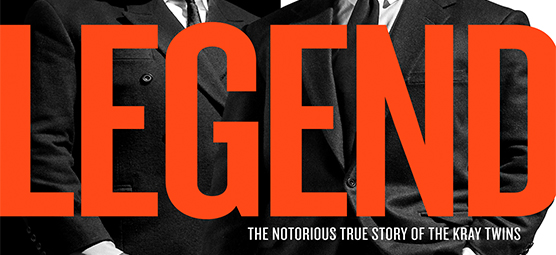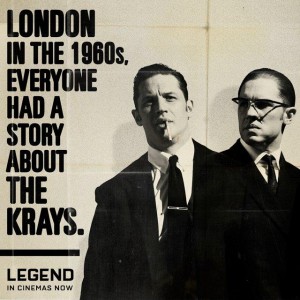“Legend” is latest film portrayal of the Kray twins
Britain’s ‘most famous gangsters’


The Kray twins, the volatile ex-boxers who went from extortion racketeers in 1950s London to nightclub-owning celebrity gangsters in the swinging ’60s, are the subject of another biopic, Legend, set for release in the United States next month.
But unlike the 1990 American film, The Krays, where real-life twins Gary and Martin Kemp (guitarists for the rock group Spandau Ballet) portrayed the pair, Legend has British actor Tom Hardy playing both characters in separately shot scenes. The $19 million movie, directed by American filmmaker Brain Helgeland, has already broken box office records in in the U.K. since its September 11 debut there, while receiving mixed reviews from critics, some asserting that the movie gets a number of things wrong about Krays.
Identical twins Ronnie and Reggie Kray were born in 1933 (Ronnie first) to Jewish and Romani parents in London’s Cockney, working-class East End. As boys, they were among the English children evacuated to the countryside while Germany bombed the city during World War II. Both were unstable by their teens (Ronnie was later diagnosed as paranoid schizophrenic). At age 17, they were charged for taking part in a gang fight. Their older brother Charlie, an accomplished boxer in the Royal Navy, trained them as amateur fighters. In 1951, all three brothers were on a boxing bill at the Royal Albert Hall, with Reggie winning his bout. Drafted into military service, the dysfunctional twins clashed with authorities and received dishonorable discharges.
Reggie turned pro as a boxer and fought seven bouts, but lost the right to continue due to his past transgressions. He and his twin brother, both trained pugilists, entered the extortion racket in the East End in the mid-’50s, strong-arming payments from shopkeepers in exchange for protection. Both were fascinated by the British mobster Billy Hill, who ran rackets in London’s Soho district, and by American gangsters such as Jack “Legs” Diamond. The twins bought a small pool hall, the Regal, in the Bethnal Green section of East End, in 1954 and used it as their base. The criminal gang they built, which included brother Charlie, was known as “The Firm.” For Ronnie, the more volatile of the twins, even the most innocuous remark from someone could trigger his violent side. Reggie perfected the “cigarette punch” – handing a victim a cigarette and delivering a jaw-breaking slug in the mouth.
Ronnie extended their rackets to the West End, ran swindles, illegal gambling, and ordered killings of rival criminals. By the early ’60s, the Krays held a tight grip through intimidation on the East End, gaining the reputation as Britain’s most infamous hoodlums. They reportedly dealt with Philadelphia Mob chieftain Angelo Bruno (played in Legend by actor and A Bronx Tale playwright Chazz Palminteri), who wanted to enter London’s illicit casino racket.
Ronnie, subject to fierce rages, was openly gay and arranged homosexual liaisons for a Conservative member of the British House of Lords and a Labor Party member of Parliament. After a newspaper published information about the arrangement with the British Lord, the politically sensitive situation led London law enforcement to look the other way, providing the Krays a cover for their criminal activities for a few years.
In the early to mid-’60s, they managed a popular London nightclub where they enjoyed hobnobbing with celebrities such as Frank Sinatra, Judy Garland, George Raft, Joe Louis, Johnny Ray and Christine Keeler, politicians, jetsetters and partiers active in the club scene. Craving the media spotlight, the twins posed for trendy fashion photographer David Bailey. In 1965, they successfully defended themselves at trial against extortion charges. Witnesses were reportedly intimidated not to testify.
But things came to a halt three years later. An investigation in London led by Detective Chief Superintendent Leonard “Nipper” Read ended with the arrests of the twins (at age 35) and eight other Firm members on murder and other allegations. Ronnie was charged with shooting George Cornell, of the rival and equally violent Richardson gang, in the forehead in view of eyewitnesses inside a pub in White Castle in 1966. Reggie allegedly lured fellow crook Jack “The Hat” McVitie — whom the Krays claimed failed to carry out a hit they paid him to perform – into a basement. While Ronnie held McVitie down in front of onlookers, Reggie stabbed the victim to death. Firm members cleaned up the gory, bloody crime scene and carried the body out in a blanket. This time, witnesses were not intimidated. Ronnie, Reggie, Charlie and other gang defendants were convicted in 1968. A judge handed the twins life sentences with a minimum 30 years in prison (a then-record sentence in the U.K.) in 1969.
Ronnie, with his schizophrenia, was soon transferred from prison to a mental facility. Both apparently remade themselves into model prisoners. Maureen Flanagan, the hairdresser of the twins’ mother, Violet, visited them often after Violet’s death. She bought Ronnie bed linens and opera records and helped him visit a tailor twice a year for fittings of the sharp suits and designer ties he wore in his ward. According to Flanagan, Reggie answered his fan letters, set up fundraisers for the needy and donated to charity his share of the rights to the 1990 Krays movie (the twins and Charlie shared 225,000 pounds). Ronnie and Reggie took oil painting classes and created many crudely executed pictures (some of which nonetheless sold well at auctions in 2009 and 2012).
The twins had brother Charlie, after his release from prison, head a London business called Krayleigh Enterprises, selling security services (as well as T-shirts), even drawing Sinatra to hire their bodyguards to protect him while in England in 1985.
Ronnie died of heart failure in custody in 1995 at age 61. Reggie, suffering from terminal cancer, was allowed early release in 2000 but died soon afterward at 66. This year, two documentaries about the Krays have come out, as well as another feature film, The Rise of the Krays, with its sequel, The Fall of the Krays, soon to follow. So far, the Krays have been the subject of more than fifty books.
The veracity of Legend has been challenged in the British media — while actor Hardy has been almost universally praised for his twin performance. Alex von Tunzelman of the London newspaper the Guardian, for instance, bestowed a grade of “D+” on the movie for historical accuracy.
For one, the movie’s portrayal of Ronnie as the crazed brother and Reggie the sane one was not entirely true, as Reggie was equally unhinged. During a fit, Reggie once cut himself and dripped blood all over his then-wife Frances as she slept (Frances, the fictional narrator in Legend, is portrayed as killing herself in 1967, although a prison mate of Reggie’s claimed he told him Ronnie killed her in a jealous rage and they covered it up). Also, the movie has Reggie murdering McVitie and telling Ronnie he did it because Ronnie was unable to. In reality, witnesses said Ronnie incited Reggie to do it.
The opening sequence of Legend depicts Ronnie in an involuntary stay at a mental hospital and the Krays intimidating a shrink into certifying him sane. Actually, the Krays bribed the shrink. But the true story of Ronnie’s real-life exit from the hospital left out of the movie is far more cinematic. Reggie paid his brother a visit in a suit and tie identical to the one Ronnie wore. Reggie left to grab tea at the cafeteria, then Ronnie, posing as twin Reggie, whisked past the unwitting nurses minutes later to Reggie’s awaiting car.
Some commentators claim the hype behind the Krays, who idolized American gangsters (along with the British public) goes beyond what they did and who they were. In a column, Guardian writer Duncan Campbell described them as “mediocre criminals” who “created their own legends” for money and attention, before and after their prison sentences. Enamored by Hollywood’s 1967 crime movies In Cold Blood and Bonnie and Clyde, they tried and failed to get In Cold Blood author Truman Capote to write their story. After their convictions, Reggie solicited and granted many interviews. Ronnie made the most out of his two marriages to women while imprisoned, obtaining 10,000 pounds for the exclusive media rights to cover his first one. After that pairing ended, Ronnie offered the media an interview with bride No. 2 for 25,000 pounds.
Whether the success of Legend in the U.K. will spill across the pond won’t be known until after its U.S. debut on November 20. While the consensus of critics on RottenTomatoes.com declared it “deeply flawed,” awarding it a 58 percent “rotten” rating (just below the 60 percent “certified fresh” good review threshold), 97 percent of movie fans rated it a “want to see.”
Feedback or questions? Email blog@themobmuseum.org





